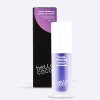Do you love coffee, blackberries, and red wine, but noticed that your diet is leaving its mark on your teeth? Gray discoloration, dark stains, or darker enamel around the gums – it’s a common issue, but not a pleasant sight in the mirror. The good news is that pigment stains on teeth can be prevented and even removed. However, it requires the right care!
Identify the Causes
Stains are essentially dark discolorations of the tooth enamel. They can be internal (caused by fluoride, certain medications, dead teeth, etc.) or external surface stains. External causes are easier to spot – usually, pigmentation comes from food or drinks rich in color pigments. Combined with poor dental hygiene, teeth may develop yellow, yellow-brown, or even blackish tones – making a bright smile much harder to achieve.
No Need to Give Up Coffee and Wine!
There are many foods and drinks that cause tooth discoloration. Coffee, tea, wine, sodas, sweet drinks, as well as tomatoes, curry, soy sauce, balsamic vinegar, candy, and fruits like blueberries and blackberries. Basically, anything that stains your tongue and mouth will also stain your teeth. Of course, this doesn’t mean you need to give up coffee, wine, or fruit! As a first aid after consuming them, rinsing your mouth with water can help.
To reduce or remove pigmentation, regular use of whitening toothpaste is very effective. For example, try our PAP+ Whitening Toothpaste.
How to Reduce Tooth Pigmentation?
Purple color correctors, whitening powders, whitening kits, whitening strips, and whitening pens also work well. However, before trying any at-home whitening, it’s best to visit your dentist. They can remove cavities, advise you on which whitening method is suitable for you, and detect any deeper causes of tooth discoloration.
Bright white teeth require care and time investment – but a beautiful (and healthy!) smile is definitely worth it. After all, it’s one of the very first things we notice about others.









